maintenance other INFINITI QX60 2019 Owner's Guide
[x] Cancel search | Manufacturer: INFINITI, Model Year: 2019, Model line: QX60, Model: INFINITI QX60 2019Pages: 540, PDF Size: 6.41 MB
Page 481 of 540
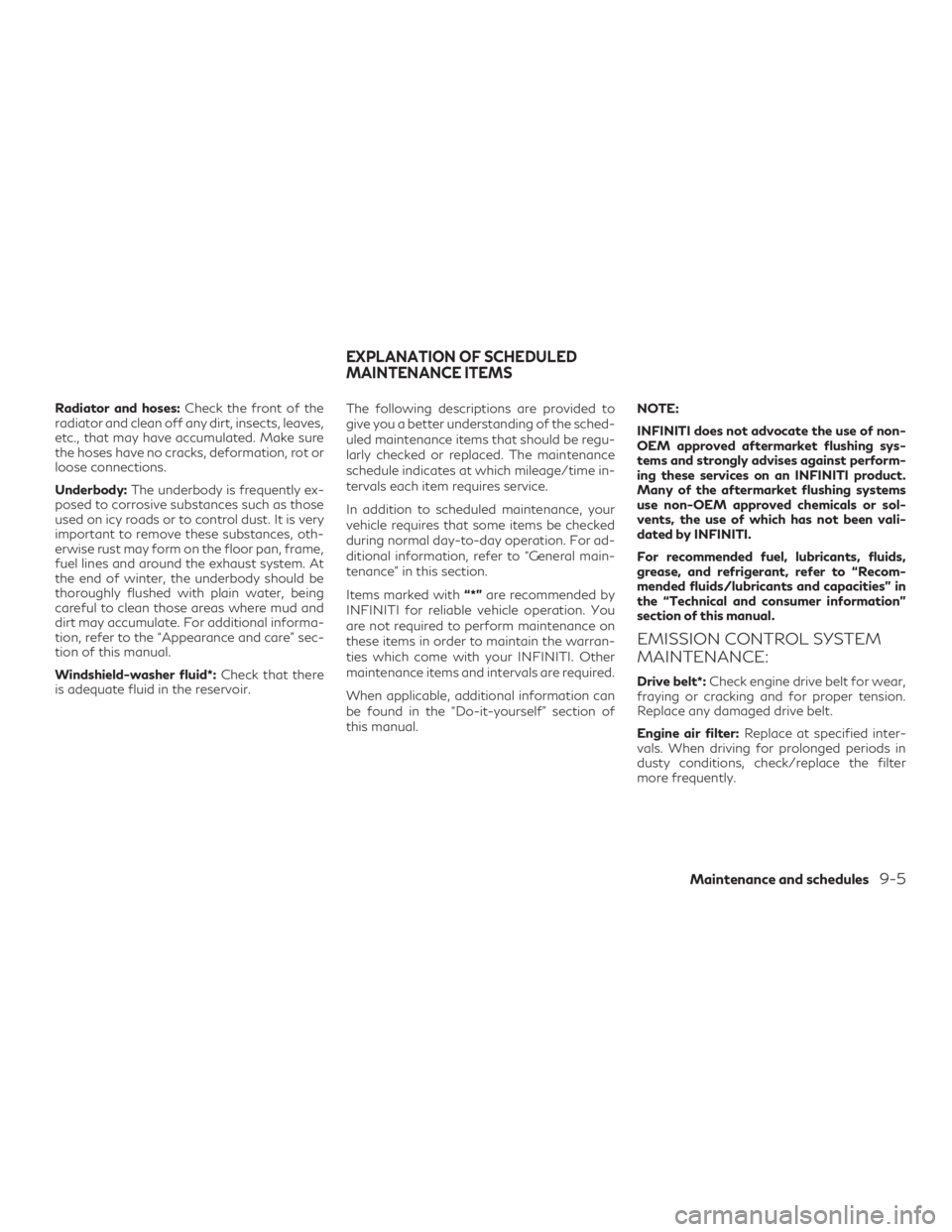
Radiator and hoses:Check the front of the
radiator and clean off any dirt, insects, leaves,
etc., that may have accumulated. Make sure
the hoses have no cracks, deformation, rot or
loose connections.
Underbody: The underbody is frequently ex-
posed to corrosive substances such as those
used on icy roads or to control dust. It is very
important to remove these substances, oth-
erwise rust may form on the floor pan, frame,
fuel lines and around the exhaust system. At
the end of winter, the underbody should be
thoroughly flushed with plain water, being
careful to clean those areas where mud and
dirt may accumulate. For additional informa-
tion, refer to the “Appearance and care” sec-
tion of this manual.
Windshield-washer fluid*: Check that there
is adequate fluid in the reservoir. The following descriptions are provided to
give you a better understanding of the sched-
uled maintenance items that should be regu-
larly checked or replaced. The maintenance
schedule indicates at which mileage/time in-
tervals each item requires service.
In addition to scheduled maintenance, your
vehicle requires that some items be checked
during normal day-to-day operation. For ad-
ditional information, refer to “General main-
tenance” in this section.
Items marked with
“*”are recommended by
INFINITI for reliable vehicle operation. You
are not required to perform maintenance on
these items in order to maintain the warran-
ties which come with your INFINITI. Other
maintenance items and intervals are required.
When applicable, additional information can
be found in the “Do-it-yourself” section of
this manual. NOTE:
INFINITI does not advocate the use of non-
OEM approved aftermarket flushing sys-
tems and strongly advises against perform-
ing these services on an INFINITI product.
Many of the aftermarket flushing systems
use non-OEM approved chemicals or sol-
vents, the use of which has not been vali-
dated by INFINITI.
For recommended fuel, lubricants, fluids,
grease, and refrigerant, refer to “Recom-
mended fluids/lubricants and capacities” in
the “Technical and consumer information”
section of this manual.
EMISSION CONTROL SYSTEM
MAINTENANCE:
Drive belt*:
Check engine drive belt for wear,
fraying or cracking and for proper tension.
Replace any damaged drive belt.
Engine air filter: Replace at specified inter-
vals. When driving for prolonged periods in
dusty conditions, check/replace the filter
more frequently.
EXPLANATION OF SCHEDULED
MAINTENANCE ITEMS
Maintenance and schedules9-5
Page 482 of 540
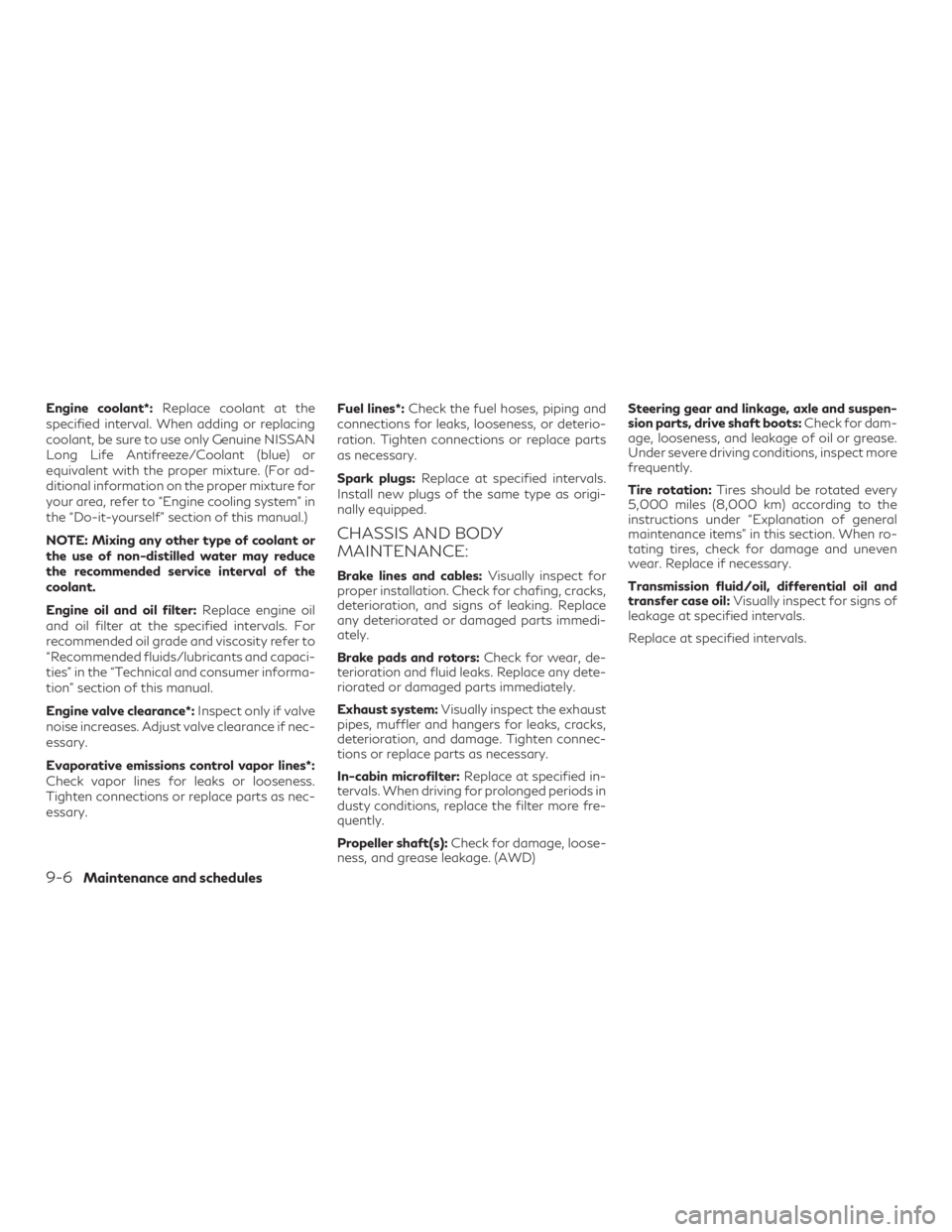
Engine coolant*:Replace coolant at the
specified interval. When adding or replacing
coolant, be sure to use only Genuine NISSAN
Long Life Antifreeze/Coolant (blue) or
equivalent with the proper mixture. (For ad-
ditional information on the proper mixture for
your area, refer to “Engine cooling system” in
the “Do-it-yourself” section of this manual.)
NOTE: Mixing any other type of coolant or
the use of non-distilled water may reduce
the recommended service interval of the
coolant.
Engine oil and oil filter: Replace engine oil
and oil filter at the specified intervals. For
recommended oil grade and viscosity refer to
“Recommended fluids/lubricants and capaci-
ties” in the “Technical and consumer informa-
tion” section of this manual.
Engine valve clearance*: Inspect only if valve
noise increases. Adjust valve clearance if nec-
essary.
Evaporative emissions control vapor lines*:
Check vapor lines for leaks or looseness.
Tighten connections or replace parts as nec-
essary. Fuel lines*:
Check the fuel hoses, piping and
connections for leaks, looseness, or deterio-
ration. Tighten connections or replace parts
as necessary.
Spark plugs: Replace at specified intervals.
Install new plugs of the same type as origi-
nally equipped.
CHASSIS AND BODY
MAINTENANCE:
Brake lines and cables: Visually inspect for
proper installation. Check for chafing, cracks,
deterioration, and signs of leaking. Replace
any deteriorated or damaged parts immedi-
ately.
Brake pads and rotors: Check for wear, de-
terioration and fluid leaks. Replace any dete-
riorated or damaged parts immediately.
Exhaust system: Visually inspect the exhaust
pipes, muffler and hangers for leaks, cracks,
deterioration, and damage. Tighten connec-
tions or replace parts as necessary.
In-cabin microfilter: Replace at specified in-
tervals. When driving for prolonged periods in
dusty conditions, replace the filter more fre-
quently.
Propeller shaft(s): Check for damage, loose-
ness, and grease leakage. (AWD) Steering gear and linkage, axle and suspen-
sion parts, drive shaft boots:
Check for dam-
age, looseness, and leakage of oil or grease.
Under severe driving conditions, inspect more
frequently.
Tire rotation: Tires should be rotated every
5,000 miles (8,000 km) according to the
instructions under “Explanation of general
maintenance items” in this section. When ro-
tating tires, check for damage and uneven
wear. Replace if necessary.
Transmission fluid/oil, differential oil and
transfer case oil: Visually inspect for signs of
leakage at specified intervals.
Replace at specified intervals.
9-6Maintenance and schedules
Page 485 of 540
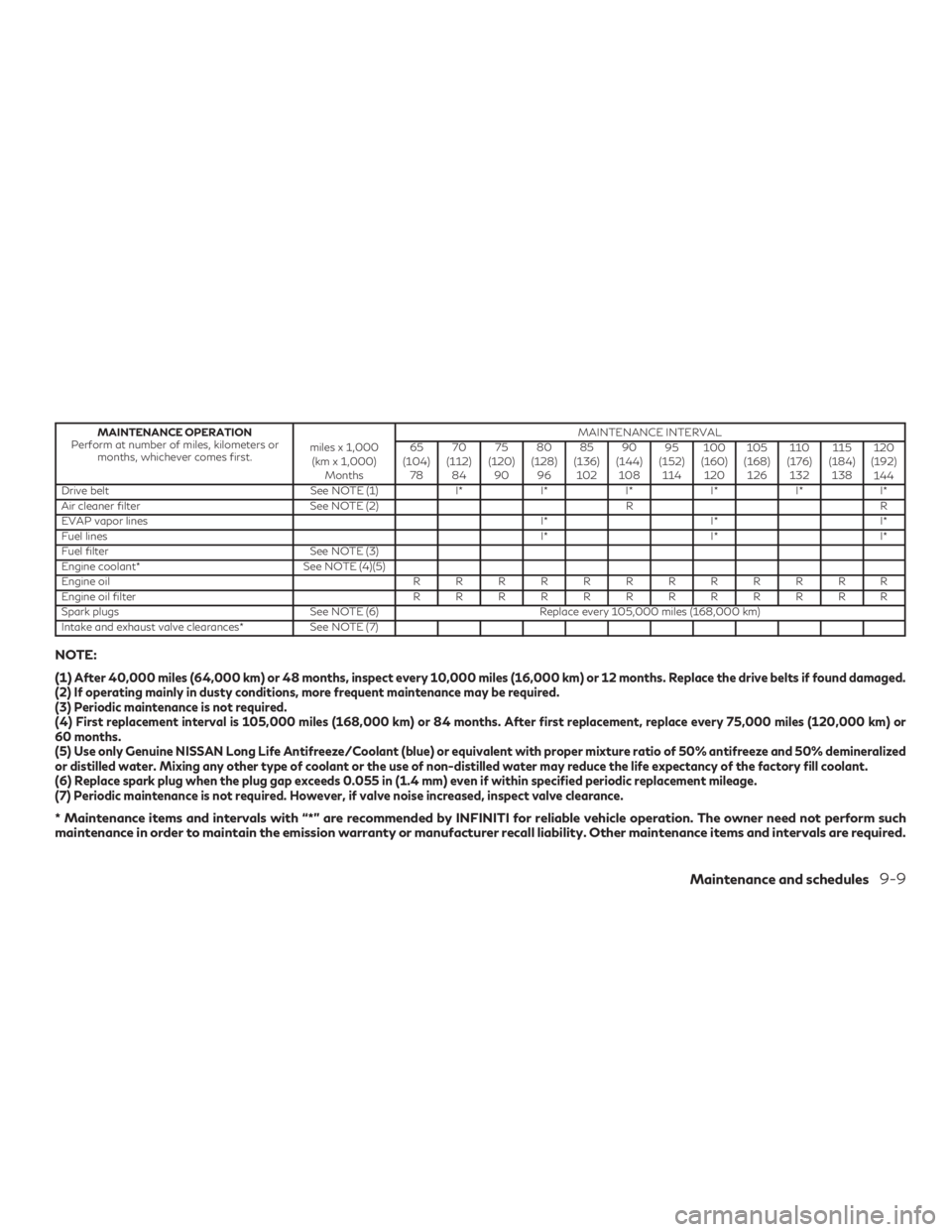
MAINTENANCE OPERATION
Perform at number of miles, kilometers or months, whichever comes first. miles x 1,000
(km x 1,000) Months MAINTENANCE INTERVAL
65
(104) 78 70
(112) 84 75
(120) 90 80
(128) 96 85
(136) 102 90
(144) 108 95
(152) 114 100
(160) 120 105
(168) 126 110
(176) 132 115
(184) 138 120
(192) 144
Drive belt See NOTE (1)I*I*I*I*I*I*
Air cleaner filter See NOTE (2) RR
EVAP vapor lines I*I*I*
Fuel lines I*I*I*
Fuel filter See NOTE (3)
Engine coolant* See NOTE (4)(5)
Engine oil RRRRRRRRRRRR
Engine oil filter RRRRRRRRRRRR
Spark plugs See NOTE (6)Replace every 105,000 miles (168,000 km)
Intake and exhaust valve clearances* See NOTE (7)
NOTE:
(1)
After 40,000 miles (64,000 km) or 48 months, inspect every 10,000 miles (16,000 km) or 12 months. Replace the drive belts if found damaged.
(2) If operating mainly in dusty conditions, more frequent maintenance may be required.
(3) Periodic maintenance is not required.
(4) First replacement interval is 105,000 miles (168,000 km) or 84 months. After first replacement, replace every 75,000 miles (120,000 km) or
60 months.
(5) Use only Genuine NISSAN Long Life Antifreeze/Coolant (blue) or equivalent with proper mixture ratio of 50% antifreeze and 50% demineralized
or distilled water. Mixing any other type of coolant or the use of non-distilled water may reduce the life expectancy of the factory fill coolant.
(6) Replace spark plug when the plug gap exceeds 0.055 in (1.4 mm) even if within specified periodic replacement mileage.
(7) Periodic maintenance is not required. However, if valve noise increased, inspect valve clearance.
* Maintenance items and intervals with “*” are recommended by INFINITI for reliable vehicle operation. The owner need not perform such
maintenance in order to maintain the emission warranty or manufacturer recall liability. Other maintenance items and intervals are required.
Maintenance and schedules9-9
Page 493 of 540
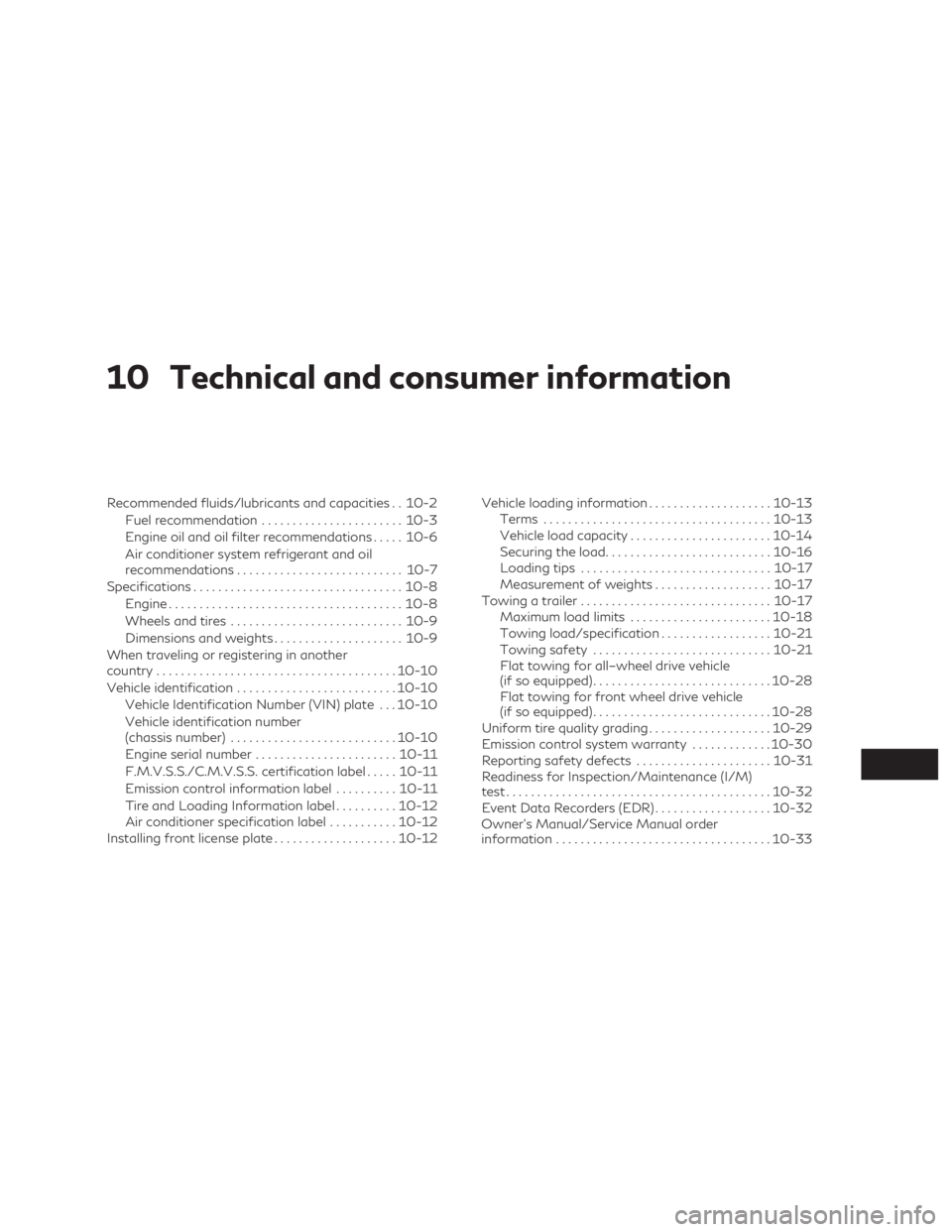
10 Technical and consumer information
Recommended fluids/lubricants and capacities . . 10-2Fuel recommendation ....................... 10-3
Engine oil and oil filter recommendations .....10-6
Air conditioner system refrigerant and oil
recommendations ........................... 10-7
Specifications .................................. 10-8
Engine ...................................... 10-8
Wheels and tires ............................ 10-9
Dimensions and weights .....................10-9
When traveling or registering in another
country ....................................... 10-10
Vehicle identification .......................... 10-10
Vehicle Identification Number (VIN) plate . . . 10-10
Vehicle identification number
(chassis number) ........................... 10-10
Engine serial number ....................... 10-11
F.M.V.S.S./C.M.V.S.S. certification label .....10-11
Emission control information label ..........10-11
Tire and Loading Information label ..........10-12
Air conditioner specification label ...........10-12
Installing front license plate ....................10-12Vehicle loading information
....................10-13
Terms ..................................... 10-13
Vehicle load capacity ....................... 10-14
Securing the load ........................... 10-16
Loading tips ............................... 10-17
Measurement of weights ...................10-17
Towing a trailer ............................... 10-17
Maximum load limits ....................... 10-18
Towing load/specification ..................10-21
Towing safety ............................. 10-21
Flat towing for all–wheel drive vehicle
(if so equipped) ............................. 10-28
Flat towing for front wheel drive vehicle
(if so equipped) ............................. 10-28
Uniform tire quality grading ....................10-29
Emission control system warranty .............10-30
Reporting safety defects ......................10-31
Readiness for Inspection/Maintenance (I/M)
test ........................................... 10-32
Event Data
Recorders (EDR) ................... 10-32
Owner’s Manual/Service Manual order
information ................................... 10-33
Page 498 of 540

ENGINE OIL AND OIL FILTER
RECOMMENDATIONS
Selecting the correct oil
It is essential to choose the correct grade,
quality and viscosity engine oil to ensure sat-
isfactory engine life and performance. For
additional information, refer to "Recom-
mended fluids/lubricants and capacities" in
this section. INFINITI recommends the use of
an energy conserving oil in order to improve
fuel economy.Select only engine oils that meet the Ameri-
can Petroleum Institute (API) certification or
International Lubricant Standardization and
Approval Committee (ILSAC) certification
and SAE viscosity standard. These oils have
the API certification mark on the front of the
container. Oils which do not have the speci-
fied quality label should not be used as they
could cause engine damage.
Oil additives
INFINITI does not recommend the use of oil
additives. The use of an oil additive is not
necessary when the proper oil type is used
and maintenance intervals are followed.Oil which may contain foreign matter or has
been previously used should not be used.
Oil viscosity
The engine oil viscosity or thickness changes
with temperature. Because of this, it is impor-
tant to select the engine oil viscosity based on
the temperatures at which the vehicle will be
operated before the next oil change. Choos-
ing an oil viscosity other than that recom-
mended could cause serious engine damage.
Selecting the correct oil filter
Your new INFINITI vehicle is equipped with a
high-quality Genuine NISSAN oil filter. When
replacing, use a Genuine NISSAN oil filter or
its equivalent for the reason described in
“Change intervals”.
Change intervals
The oil and oil filter change intervals for your
engine are based on the use of the specified
quality oils and filters. Using engine oil and
filters that are not of the specified quality, or
exceeding recommended oil and filter change
intervals could reduce engine life. Damage to
the engine caused by improper maintenance
or use of incorrect oil and filter quality and/or
viscosity is not covered by the INFINITI New
Vehicle Limited Warranty.
LTI2051
10-6Technical and consumer information
Page 499 of 540
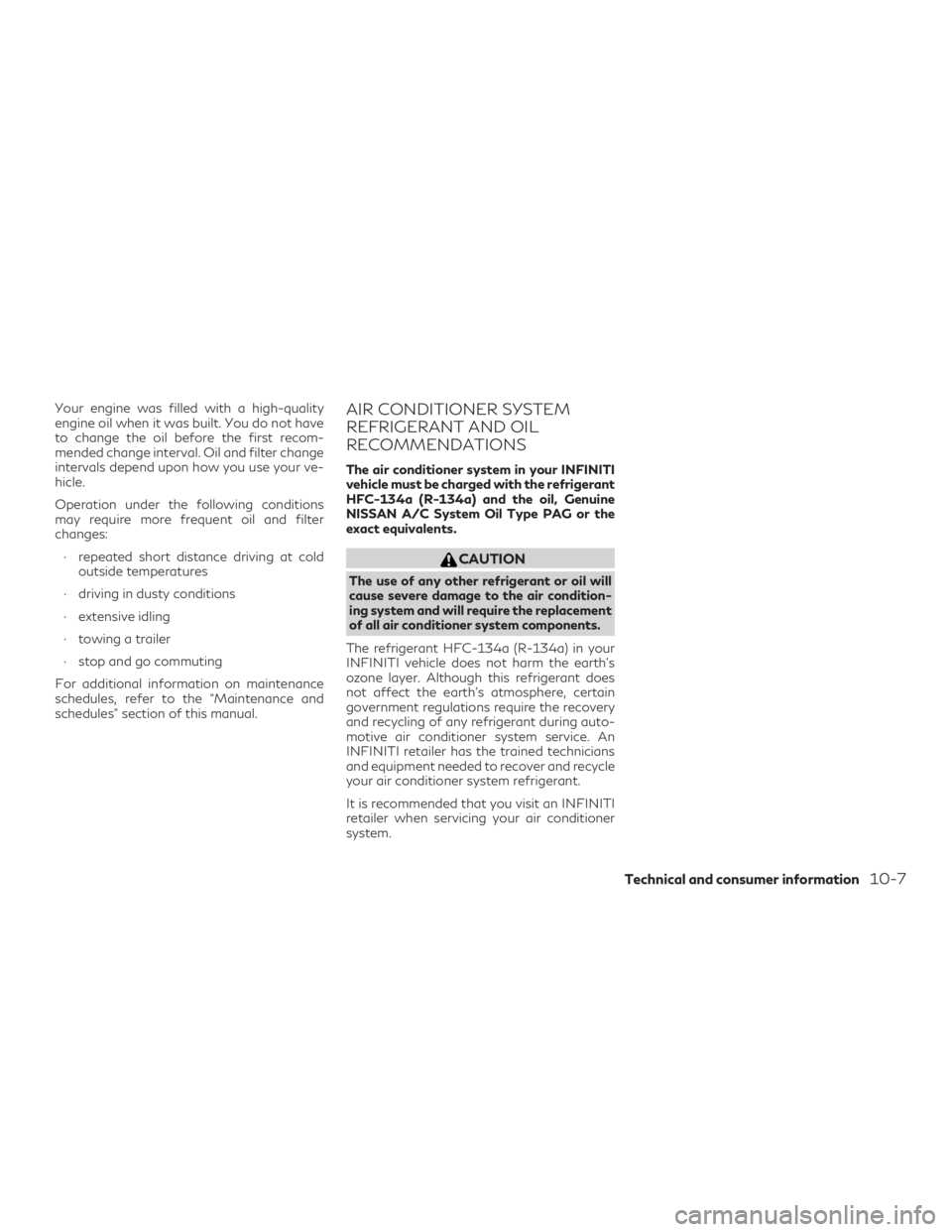
Your engine was filled with a high-quality
engine oil when it was built. You do not have
to change the oil before the first recom-
mended change interval. Oil and filter change
intervals depend upon how you use your ve-
hicle.
Operation under the following conditions
may require more frequent oil and filter
changes:∙ repeated short distance driving at cold outside temperatures
∙ driving in dusty conditions
∙ extensive idling
∙ towing a trailer
∙ stop and go commuting
For additional information on maintenance
schedules, refer to the “Maintenance and
schedules” section of this manual.AIR CONDITIONER SYSTEM
REFRIGERANT AND OIL
RECOMMENDATIONS
The air conditioner system in your INFINITI
vehicle must be charged with the refrigerant
HFC-134a (R-134a) and the oil, Genuine
NISSAN A/C System Oil Type PAG or the
exact equivalents.
CAUTION
The use of any other refrigerant or oil will
cause severe damage to the air condition-
ing system and will require the replacement
of all air conditioner system components.
The refrigerant HFC-134a (R-134a) in your
INFINITI vehicle does not harm the earth’s
ozone layer. Although this refrigerant does
not affect the earth’s atmosphere, certain
government regulations require the recovery
and recycling of any refrigerant during auto-
motive air conditioner system service. An
INFINITI retailer has the trained technicians
and equipment needed to recover and recycle
your air conditioner system refrigerant.
It is recommended that you visit an INFINITI
retailer when servicing your air conditioner
system.
Technical and consumer information10-7
Page 519 of 540
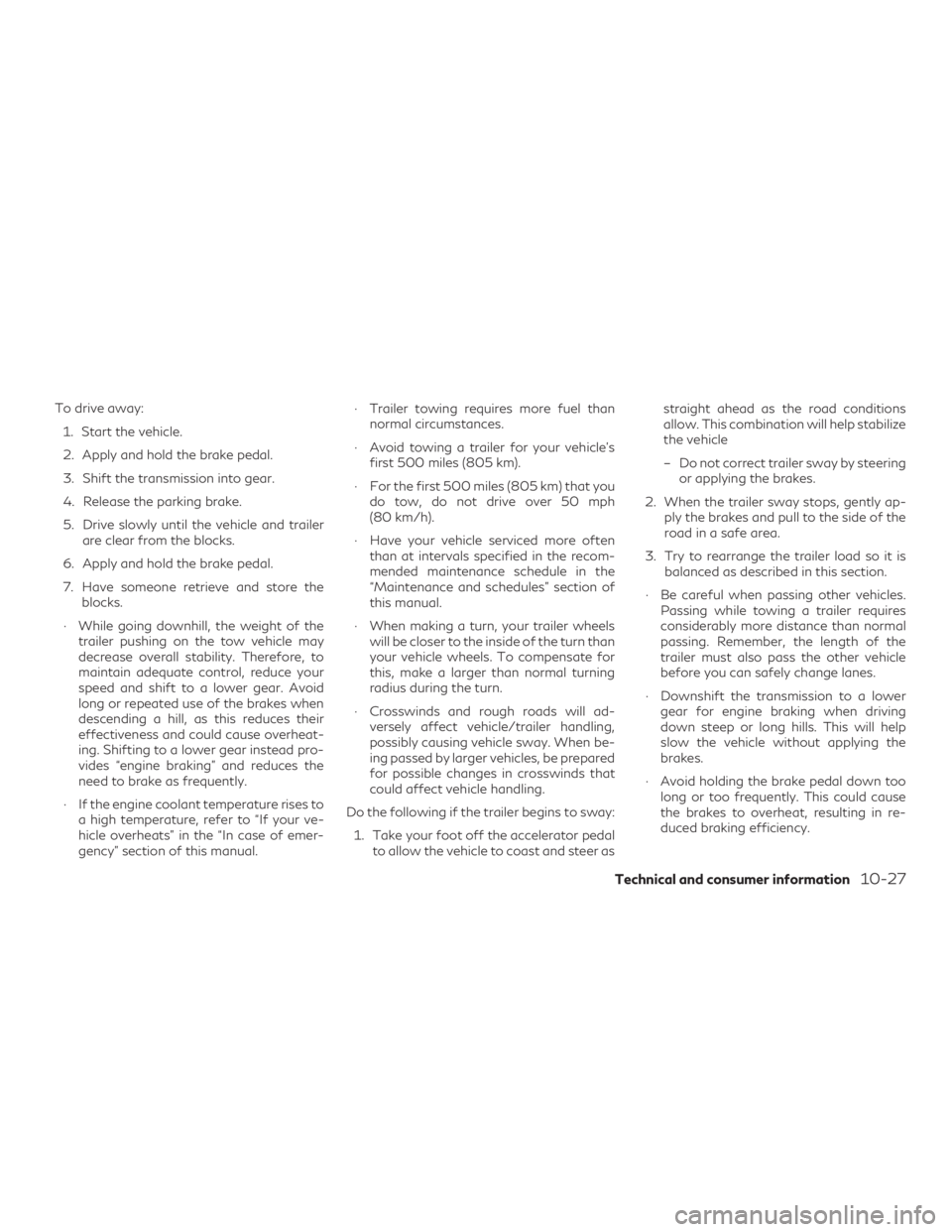
To drive away:1. Start the vehicle.
2. Apply and hold the brake pedal.
3. Shift the transmission into gear.
4. Release the parking brake.
5. Drive slowly until the vehicle and trailer are clear from the blocks.
6. Apply and hold the brake pedal.
7. Have someone retrieve and store the blocks.
∙ While going downhill, the weight of the trailer pushing on the tow vehicle may
decrease overall stability. Therefore, to
maintain adequate control, reduce your
speed and shift to a lower gear. Avoid
long or repeated use of the brakes when
descending a hill, as this reduces their
effectiveness and could cause overheat-
ing. Shifting to a lower gear instead pro-
vides “engine braking” and reduces the
need to brake as frequently.
∙ If the engine coolant temperature rises to a high temperature, refer to “If your ve-
hicle overheats” in the “In case of emer-
gency” section of this manual. ∙ Trailer towing requires more fuel than
normal circumstances.
∙ Avoid towing a trailer for your vehicle’s first 500 miles (805 km).
∙ For the first 500 miles (805 km) that you do tow, do not drive over 50 mph
(80 km/h).
∙ Have your vehicle serviced more often than at intervals specified in the recom-
mended maintenance schedule in the
“Maintenance and schedules” section of
this manual.
∙ When making a turn, your trailer wheels will be closer to the inside of the turn than
your vehicle wheels. To compensate for
this, make a larger than normal turning
radius during the turn.
∙ Crosswinds and rough roads will ad- versely affect vehicle/trailer handling,
possibly causing vehicle sway. When be-
ing passed by larger vehicles, be prepared
for possible changes in crosswinds that
could affect vehicle handling.
Do the following if the trailer begins to sway: 1. Take your foot off the accelerator pedal to allow the vehicle to coast and steer as straight ahead as the road conditions
allow. This combination will help stabilize
the vehicle
– Do not correct trailer sway by steering or applying the brakes.
2. When the trailer sway stops, gently ap- ply the brakes and pull to the side of the
road in a safe area.
3. Try to rearrange the trailer load so it is balanced as described in this section.
∙ Be careful when passing other vehicles. Passing while towing a trailer requires
considerably more distance than normal
passing. Remember, the length of the
trailer must also pass the other vehicle
before you can safely change lanes.
∙ Downshift the transmission to a lower gear for engine braking when driving
down steep or long hills. This will help
slow the vehicle without applying the
brakes.
∙ Avoid holding the brake pedal down too long or too frequently. This could cause
the brakes to overheat, resulting in re-
duced braking efficiency.
Technical and consumer information10-27
Page 531 of 540
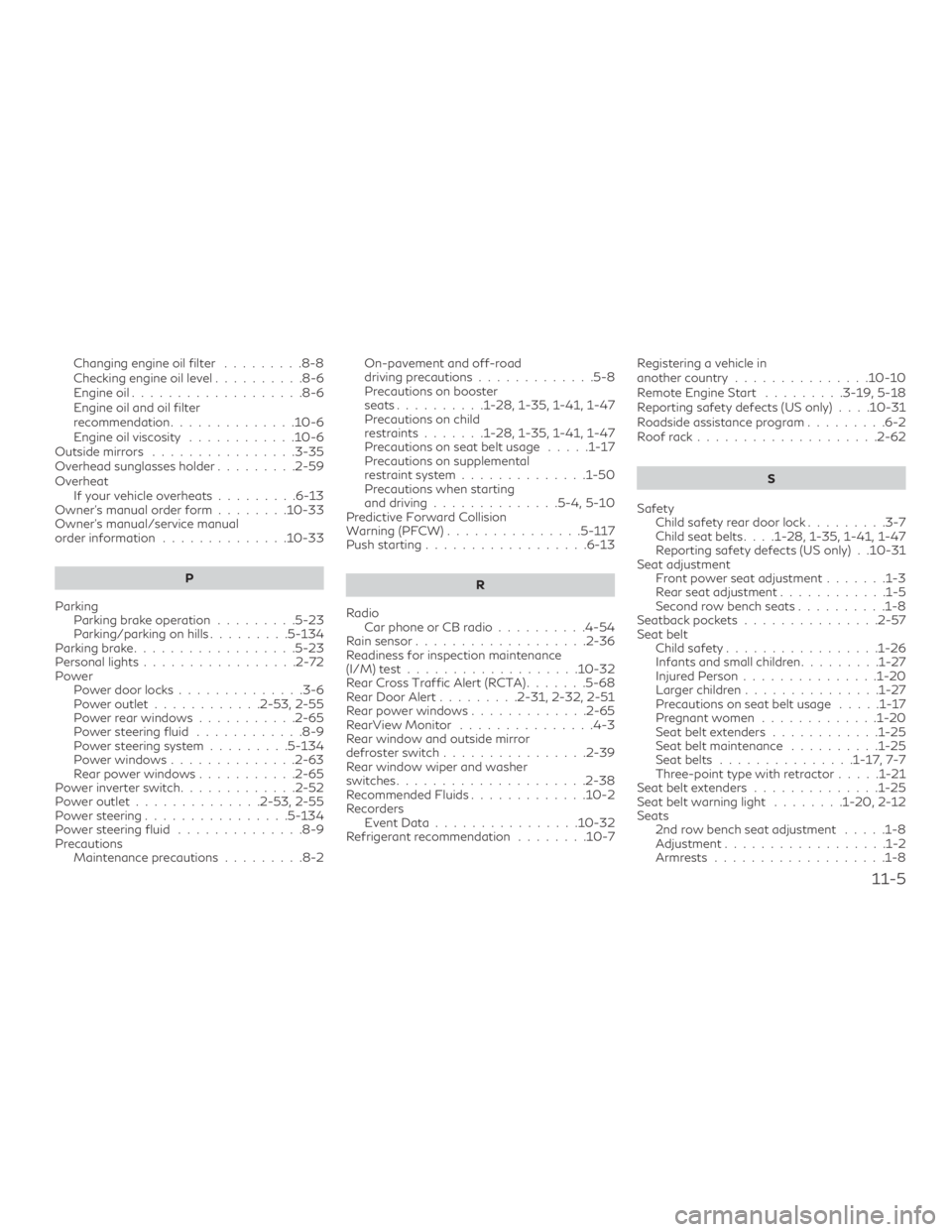
Changing engine oil filter.........8-8
Checking engine oil level ..........8-6
Engine oil ...................8-6
Engine oil and oil filter
recommendation ..............10-6
Engine oil viscosity ............10-6
Outside mirrors ................3-35
Overhead sunglasses holder .........2-59
Overheat If your vehicle overheats .........6-13
Owner's manual order form ........10-33
Owner's manual/service manual
orderinformation ..............10-33
P
Parking Parking brake operation .........5-23
Parking/parking on hills .........5-134
Parkingbrake..................5-23
Personal lights .................2-72
Power Power door locks ..............3-6
Power outlet ............2-53,2-55
Power rear windows ...........2-65
Power steering fluid ............8-9
Power steering system .........5-134
Power windows ..............2-63
Rear power windows ...........2-65
Power inverter switch .............2-52
Power outlet ..............2-53,2-55
Power steering ................5-134
Power steering fluid ..............8-9
Precautions Maintenance precautions .........8-2On-pavement and off-road
driving precautions
.............5-8
Precautions on booster
seats..........1-28,1-35,1-41,1-47
Precautions on child
restraints .......1-28,1-35,1-41,1-47
Precautionsonseatbeltusage .....1-17
Precautions on supplemental
restraint system ..............1-50
Precautions when starting
and driving ..............5-4,5-10
Predictive Forward Collision
Warning(PFCW)...............5-117
Push starting ..................6-13
R
Radio Car phone or CB radio ..........4-54
Rainsensor...................2-36
Readiness for inspection maintenance
(I/M)test...................10-32
Rear Cross Traffic Alert (RCTA) .......5-68
Rear Door Alert .........2-31,2-32,2-51
Rear power windows .............2-65
RearView Monitor ...............4-3
Rear window and outside mirror
defroster switch ................2-39
Rear window wiper and washer
switches .....................2-38
Recommended Fluids .............10-2
Recorders Event Data ................10-32
Refrigerant recommendation ........10-7Registering a vehicle in
anothercountry...............10-10
Remote Engine Start
.........3-19,5-18
Reporting safety defects (US only) ....10-31
Roadside assistance program .........6-2
Roof rack ....................2-62
S
Safety Child safety rear door lock .........3-7
C h
ildseatbelts....1-28, 1-35, 1-41, 1-47
Reporting safety defects (US only) . .10-31
Seat adjustment Front power seat adjustment .......1-3
Rear seat adjustment ............1-5
Second row bench seats ..........1-8
Seatback pockets ............... 2-57
Seat belt Childsafety.................1-26
Infantsandsmallchildren.........1-27
Injured Person ...............1-20
Largerchildren...............1-27
Precautionsonseatbeltusage .....1-17
Pregnant women .............1-20
Seat belt extenders ............1-25
Seat belt maintenance ..........1-25
Seat belts ...............1 -17, 7-7
Three-point type with retractor .....1-21
Seat belt extenders ..............1-25
Seat belt warning light ........1-20,2-12
Seats 2nd row bench seat adjustment .....1-8
Adjustment ..................1-2
Armrests ...................1-8
11-5